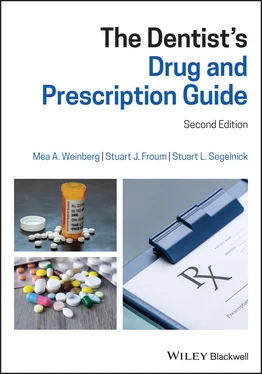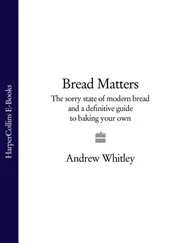23 Q. What are the peak blood levels of antibiotics used in dentistry?
24 A. See Table 3.1. Table 3.1 Peak blood levels of antibioticsDrugTime to peakAmoxicillin1–2 hoursAzithromycin (Zithromax®)2.5–4 hoursClindamycin45–60 minutesDoxycycline1–2 hoursPenicillin VK30–60 minutesTetracycline2–4 hours
25 Q. What are the peak levels of common analgesics used in dentistry?
26 A. See Table 3.2 Table 3.2 Peak levels of common analgesicsDrugTime to peakAcetaminophen0.5–2 hoursCodeine1–1.5 hoursDiflunisal (Dolobid®)2–3 hoursIbuprofen1–2 hoursMeperidine (Demerol®)1 hourNaproxen sodium (Aleve, Anaprox®)1 hourOxycodone30–60 minutes
27 Q. What is the difference in prescribing capsules or tablets (e.g., doxycycline 100 mg comes in tablets and capsules)?
28 A. If a patient has difficulty swallowing capsules, prescribe tablets. To be absorbed, capsules need to undergo dissolution or to be opened (usually takes about four minutes) and tablets need to undergo disintegration or to break up (takes slightly longer than a capsule) to release the active ingredient that will be absorbed. Both processes take time and absorption will occur in the duodenum (small intestine). A liquid gel capsule (Aleve®, Advil®) is formulated to dissolve quickly which allows the liquid inside the capsule to be absorbed fast. A gel capsule is a capsule‐shaped tablet coated with gelatin for easy swallowing. Basically, it is a tablet and not a capsule. That means it will be absorbed like a tablet, but it may take longer to disintegrate because the gelatin must disintegrate first and then the tablet. Liquid drug (e.g., solution) is absorbed most rapidly, followed by liquid gel capsule, capsule, tablet, and then gel capsule.
29 Q. What happens if a patient misses a dose of an antibiotic?
30 A. It is important not to miss doses because drugs that require daily administration are only effective when they achieve steady state in the blood, which is required for a medication to reach therapeutic and effective levels. This means that steady state occurs when the amount of drug entering the blood equals the amount of drug being eliminated from the body. Ideally, doses should be equally spaced throughout the day and taken at the same times each day. This will help to maintain a constant level of antibiotic in the bloodstream. If the patient misses a dose of an antibiotic, it is best not to double the next dose because this could increase the incidence of adverse effects. If you miss a dose, take it as soon as remembered; do not take if it is almost time for the next dose. Instead, skip the missed dose and resume your usual dosing schedule. Do not “double up” the doses.
31 Q. What does first‐pass effect have to do with drug dosing?
32 A. First‐pass effect is defined as the biotransformation of a drug in the liver that occurs before the drug enters the systemic circulation. For example, sublingual nitroglycerin has a high first‐pass metabolism because 90% of it is inactivated by the liver before it enters the blood. Morphine and lidocaine are other drugs with high first‐pass effect when administered orally. Because this, they cannot be given orally because they would be totally inactivated before reaching the target site.
33 Q. How does age affect drug metabolism?
34 A. Age often affects drug metabolism and drug dosages may need to be adjusted in children and the elderly. Years ago, pediatric dosing was determined using pediatric formulas such as Clark's Rule, Young's Rule and Fried's Rule, which were based on the weight of the child in pounds or on their age in months. Today, these formulations are not used but rather the dose is based on body surface area or weight of the infant/child. In order to calculate the proper dosage, the manufacturer's safe dose (in mg/kg) of the prescribed drug must be known. This dose is predetermined by the manufacturer.Children and the elderly require lower drug doses due to differences in their response to drugs.
*Note: The prescriber should use their own judgment in prescribing for pediatric patients. The prescriptions in this section are not absolute numbers, only suggestions.
1 Q. Are there standardized dosage recommendations for children?
2 A. Yes. The dosage is dependent on the age and weight of the child. It should be noted that there is a wide range of correct dosages for a drug. Usually, drug information for pediatric dosage (mg/kg) is supplied by the drug manufacturer. For example, the dose recommendations for children on amoxicillin range from 20 to 45 mg/kg body weight per day depending on weight and height of the patient and the severity (mild or severe infection) of the medical condition. ( www.emiphysicians.com/calculator1.html).
3 Q. Should a solid dose form or liquid suspension or solution be given to a pediatric patient?
4 A. It depends on the age and weight of the child but always ask the parent if the child can swallow a pill. Sometimes when calculating dosage, it may be more accurate to give a liquid dosage form.
5 Q. What is the difference between mL and cc?
6 A. mL (milliliters) is sometimes referred to as cc or cubic centimeters. Sometimes, a medical dropper will have markers in cc; cc is the same as mL.
7 Q. How does the parent accurately measure out teaspoonfuls or mL?
8 A. Medicine droppers and spoons are available in the pharmacy. The dropper and spoon have measurements in medical teaspoonful (tsp) and mL. The patient should be cautioned not to use a household teaspoon because it can vary in size.
9 Q. What should be prescribed if the calculation for a pediatric dose is, for example, 275 mg for penillicin V?
10 A. Since there is no dosage strength available for 275 mg, it is recommended to always use the lower dose and then increase the number of days of therapy (prescribe the antibiotic for 10 days rather than seven days) or to use the suspension instead.
11 Q. What directions should be given to the parent about oral suspensions?
12 A. Oral suspensions should be shaken very well and stored in the refrigerator. Any unused medicine should be discarded after 14 days.
13 Q. Given the following case, what dosage of penicillin V should be prescribed to this child?
14 A. 10‐year‐old male patient who weighs 32 kg (70 lbs) has an endodontic abscess that is not draining. An antibiotic should be prescribed. Penicillin V is the drug of choice. The antibiotic can be prescribed as an oral suspension or as a tablet.
3.2.1 Penicillin V Oral Suspension
Steps to follow when prescribing for a pediatric patient: www.drugguide.com/ddo/ub/view/Davis‐Drug‐Guide/109514/0/Pediatric_Dosage_Calculations
What is the dose for the age of the child? This information can be obtained from a drug reference source. This is a set dosage for a child of that age and weight.Dose required: <12 year: 15–30 mg/kg/d q6–8 h; max. 3 g/day × 7–10 days (this is an established dosage obtained from a drug reference source).
If it is decided to give an oral suspension, the amount of active ingredient in the suspension must be known. This information is also obtained from a drug reference book.How supplied: oral suspension 125 mg/5 mL; 250 mg/5 mL (100 mL bottle). Table 3.3 Calculation for correct dose to give to a pediatric patientStep 1 Convert pounds to kg:70 lb × 1 kg/2.2 lb = 31.8 kgStep 2 Calculate the dose in mg:31.8 kg × 15 mg/kg/day = 477 mg/dayStep 3 Divide the dose by the frequency:477 mg/day ÷ 3 (tid) = 159 mg/dose q8hStep 4 Convert the mg dose to mL:159 mg/dose ÷ 125 mg/5 mL = 6.36 mL qidStep 5 Convert mL to teaspoonfuls a 6.36 mL ÷ 5 mL = 1.27 teaspoonful (round to 1¼ teaspoonful) a Each teaspoonful is 5 mL.Calculation for 159 mg/dose ÷ 125 mg/5 mL is the following: 159 x 5 ÷ 125 = 6.36. Table 3.4 How the prescription is writtenRx Penicillin V oral suspension 250 mg/5 mLDisp: 1 bottle (100 mL)Sig: Take 1¼ teaspoonful orally three times a day for 7 days for dental infectioAdvise the parent to use a medicine dropper/spoon rather than an ordinary teaspoon because of variations in measurements. After penicillin V solution is mixed, it is best to store it in a refrigerator between 2 °C and 7 °C (36–46 °F); do not freeze. Throw away any unused medicine after 14 days.
Читать дальше












